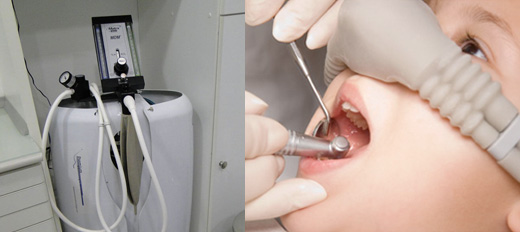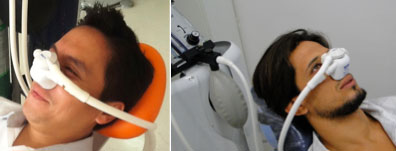Nitrous Oxide
Nitrous oxide conscious sedation
Approximately 15% of the population in the United States avoid dental treatment due to fear of the needle for local anesthesia. The nitrous oxide inhalation analgesia, a substance that began to be used for more than a century for conscious sedation, is one of the alternatives in use in USA and in the world. It has the objective to reduce the discomfort of the patient with high security and make the procedure more relaxed for the individual who needs dental care. It can be used in accordance with any special needs of patients.
The technique has proved very useful in dealing with patients who needs special attention, as patients with cardiovascular, respiratory, neurovascular, liver, convulsive and epilepsy, allergies, pregnant women, diabetics and patients with vomiting spells. But it can be used, with several advantages, in most individuals, particularly the ones that sufferers with trauma or who have fear of the dentist.
There are no absolute contraindications to the use of nitrous oxide, but relative contraindications. Included in these precautionary conditions are patients with sinusitis or colds, poor communication, previous respiratory tract obstruction, chronic obstructive patients (COPD) and mentally unstable patients.


Frequently Asked Questions
The Conscious Sedation is the use of nitrous oxide associated with the oxygen in mixtures whose rate is variable, providing intense relaxation, conscious sedation, analgesia and consequent control of fear, “stress” and anxiety. This gas is responsible for the release of endorphins, which is an endogenous hormone, similar to morphine, which has a potent analgesic effect.
Inhalation analgesia with nitrous oxide is the only technique of sedation, which allows the complete recovery of the patient in a short time after sedation, ie: 3 to 5 minutes, 98% of cases will be able the return to their activities, including driving and operating machinery, because 99% of nitrous oxide have been exhaled from the body through breathing.
Yes. Since nitrous oxide has analgesic properties, there is a reduction in the consumption of local anesthetics.
Yes. Discovered by Horace Wells in 1844, this technique is in wide use in the United States of America since 1930. Other countries followed this example and today this is an option spread in many First World countries: United Kingdom, Japan, France, Sweden, Norway, Australia and New Zealand are examples of nations that use this means of controlling pain and anxiety in dentistry.
Yes. Although any anesthetic and / or treatment have itself a risk, sedation with nitrous oxide is considered one of the safest anesthetic methods in use today. There are no reports of death exclusively attributed to sedation with nitrous oxide + oxygen in the literature.
No. Sedation with nitrous oxide and oxygen is a method that adequately produces mild somnolence, decreased soreness and decreased anxiety, but keeps the patient awake, cooperative, spontaneously breathing and with all your protective reflexes intact.
Using equipment developed specifically for this purpose, the dentist attaches a nasal mask to the patient. Through devices installed on the device, the professional controls the mixture of gases (oxygen + nitrous oxide), providing nitrous oxide concentrations between 0 (zero) and 70%, ensuring that patients receive at least 30% oxygen.
Yes, the 5081 law, which regulates the practice of dentistry in Brazil, ensures the use of hypnosis and analgesia, since the professional is enabled and credit is given. The resolution of the CFO 51/2004 regulates the courses of qualification and ended the controversy over the legality of the use of the technique by surgeons Dentists.
Yes. Techniques to reduce pain and stress are part of the tactic of proper care for these patients. However, a good medical evaluation should be made to ensure that these patients are adequately compensated at the time of surgery.
No, quite the contrary. Although general anesthesia, intravenous and oral sedation are widely used in these countries, a survey of the UK NHS, done in 2002 recommended that the first technique to be employed in dentistry to reduce pain and anxiety is precisely the conscious sedation with oxygen and nitrous oxide. The reasons are low cost and, above all, the great safety of the method.
Pediatric Dentistry, complex procedures (implants, extraction of third molars) and patients who are afraid of the dentist.
According to Malamed in 2003 and Clark & Brunick in 2004 contraindications are only relative and not absolute.
• Patients with compulsive personality – especially those who do not allow the loss of control.
• Patients with claustrophobia – who do not tolerate the placement of a nasal mask.
• Children with severe behavior problems.
• Patients with severe personality disorders. Patients who do not require the use of sedation techniques, patients with COPD classified as ASA III and IV.


